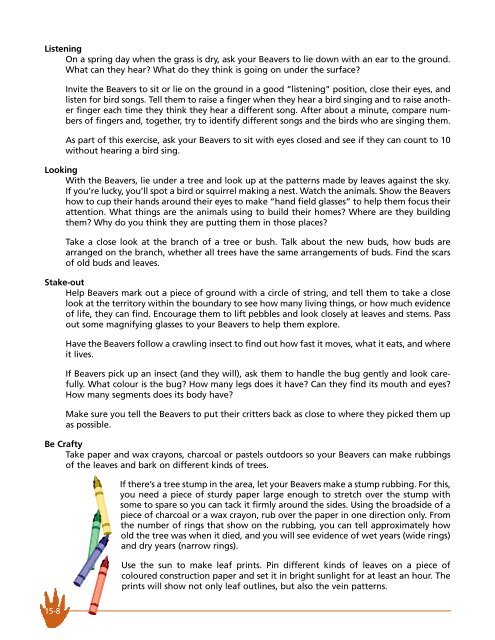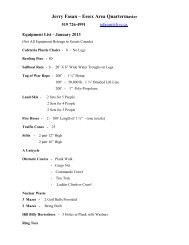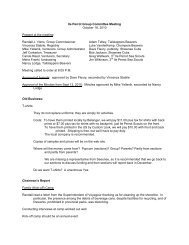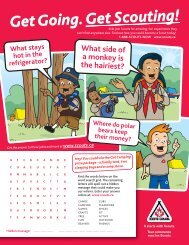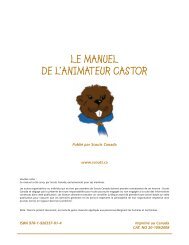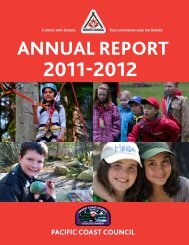Beaver Leader's Handbook - Scouts Canada
Beaver Leader's Handbook - Scouts Canada
Beaver Leader's Handbook - Scouts Canada
You also want an ePaper? Increase the reach of your titles
YUMPU automatically turns print PDFs into web optimized ePapers that Google loves.
Listening<br />
On a spring day when the grass is dry, ask your <strong>Beaver</strong>s to lie down with an ear to the ground.<br />
What can they hear? What do they think is going on under the surface?<br />
Invite the <strong>Beaver</strong>s to sit or lie on the ground in a good “listening” position, close their eyes, and<br />
listen for bird songs. Tell them to raise a finger when they hear a bird singing and to raise another<br />
finger each time they think they hear a different song. After about a minute, compare numbers<br />
of fingers and, together, try to identify different songs and the birds who are singing them.<br />
As part of this exercise, ask your <strong>Beaver</strong>s to sit with eyes closed and see if they can count to 10<br />
without hearing a bird sing.<br />
Looking<br />
With the <strong>Beaver</strong>s, lie under a tree and look up at the patterns made by leaves against the sky.<br />
If you’re lucky, you’ll spot a bird or squirrel making a nest. Watch the animals. Show the <strong>Beaver</strong>s<br />
how to cup their hands around their eyes to make “hand field glasses” to help them focus their<br />
attention. What things are the animals using to build their homes? Where are they building<br />
them? Why do you think they are putting them in those places?<br />
Take a close look at the branch of a tree or bush. Talk about the new buds, how buds are<br />
arranged on the branch, whether all trees have the same arrangements of buds. Find the scars<br />
of old buds and leaves.<br />
Stake-out<br />
Help <strong>Beaver</strong>s mark out a piece of ground with a circle of string, and tell them to take a close<br />
look at the territory within the boundary to see how many living things, or how much evidence<br />
of life, they can find. Encourage them to lift pebbles and look closely at leaves and stems. Pass<br />
out some magnifying glasses to your <strong>Beaver</strong>s to help them explore.<br />
Have the <strong>Beaver</strong>s follow a crawling insect to find out how fast it moves, what it eats, and where<br />
it lives.<br />
If <strong>Beaver</strong>s pick up an insect (and they will), ask them to handle the bug gently and look carefully.<br />
What colour is the bug? How many legs does it have? Can they find its mouth and eyes?<br />
How many segments does its body have?<br />
Make sure you tell the <strong>Beaver</strong>s to put their critters back as close to where they picked them up<br />
as possible.<br />
Be Crafty<br />
Take paper and wax crayons, charcoal or pastels outdoors so your <strong>Beaver</strong>s can make rubbings<br />
of the leaves and bark on different kinds of trees.<br />
15-8<br />
If there’s a tree stump in the area, let your <strong>Beaver</strong>s make a stump rubbing. For this,<br />
you need a piece of sturdy paper large enough to stretch over the stump with<br />
some to spare so you can tack it firmly around the sides. Using the broadside of a<br />
piece of charcoal or a wax crayon, rub over the paper in one direction only. From<br />
the number of rings that show on the rubbing, you can tell approximately how<br />
old the tree was when it died, and you will see evidence of wet years (wide rings)<br />
and dry years (narrow rings).<br />
Use the sun to make leaf prints. Pin different kinds of leaves on a piece of<br />
coloured construction paper and set it in bright sunlight for at least an hour. The<br />
prints will show not only leaf outlines, but also the vein patterns.


